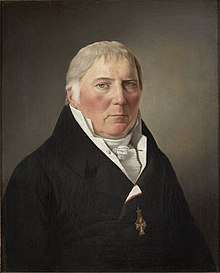Iselingen
Iselingen is a manor house and estate located close to Vordingborg on the southern part of Zealand in southeastern Denmark. It takes its name after the Swiss-born merchant Reinhard Iselin who established it in the 1770s. The current main building was completed a hundred years later to design by Vilhelm Dahlerup.
| Iselingen | |
|---|---|
.jpg) Vintage photo of the main building | |
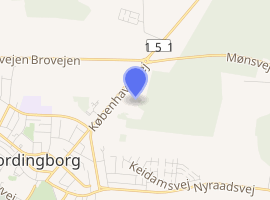
| |
| General information | |
| Architectural style | Historicism |
| Location | Vordingborg Municipality |
| Country | Denmark |
| Coordinates | 55°0′58″N 11°55′38″E |
| Construction started | 1802 |
| Renovated | 1869–74 |
| Design and construction | |
| Architect | Vilhelm Dahlerup |
History
The Iselin family
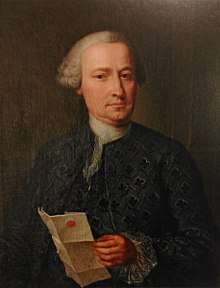
Iselingen was created when the former Vordingborg Cavalry District was divided into 12 estates and sold in auction by the crown in 1774. One of them was the former Vordingborg Castle. The castle was a ruin but the land and its tenant farms were acquired by the merchant Reinhard Iselin who gave it the name Iselingen. He also acquired one of the other estates, Vordingborg Castle's former home farm (Vordingborg Ladegård), which was named [[Rosenfeld]t]]. Iselin was ennobled with title of baron in 1776. When he died in 1781, his widow Anna Elisabeth Iselin née Fanritius founded Stamhuset Iselingen for their oldest daughter Marie Margrethe Iselin. Rosenfeldt was also turned into a stamhus and passed on to the younger daughter Anna Elisabeth Iselin. The legal effect of a stamhus was that the estate could not be sold or divided between several heirs. Datteren Marie Margrethe was married to Christian Frederik Ernst Rantzau but the couple was—highly unusually for the time—divorced in 1793. In 1802, she began the construction of a new main building at a site located to the northeast of the old castle ruin.[1]
In 1803, Stamhuset Iselingen was dissolved and replaced by a family trust (fideikommis). The estate was then sold to ship captain Jens Lind.
Aagaard and Hammerich
After about a year, Lind sold Iselingen to district manager (amtsforvalter) H. H. P. Reiersen who shortly thereafter sold it to a consortium from Copenhagen consisting of Just Michael Aagaard, Peder Bech, Iver Qvistgaard and Hans Wassard. They also acquired nearby Marienlyst Manor. Aagaard became the sole owner of Iselingen in 1806 while Wassard acquired full ownership of Marienlyst in 1810.
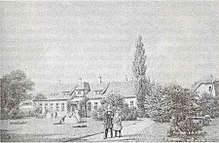
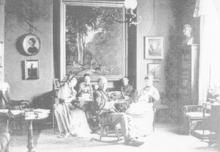
Aagaard offered his son Holger Halling Aagaard to become manager of the estate. Recently engaged to 18-year old Marie Koës, he consulted his fiancé on the matter and she responded with a "Yes let's move to Iselingen, then I can have a large garden with lots of flowers and strawberries!".[2] Holger Halling Aagaard managed the estate with great skill and inherited it in 1819. He owned Iselingen until 1866 and it won a reputation for being the most well-run estate in the country. He was very interested in both art and science and socialized with many of the most prominent figures of his day. His visitors at Iselingen included the Ørsted brothers, Grundtvig, Bertel Thorvaldsen, Adam Oehlenschlägerand Christian Winther.[3]
Holger Aagaard's son, Georg Aagaard, a National Liberal politician who was a member of the Constituent Assembly that prepared the Danish constitution of 1849, died before his father. Iselingen was therefore passed on to Holger Aagaard's son-in-law Martin Hammerich, a scholar specializing in Norse linguistics, culture, history. His home at Iselingen became a meeting place for many of the most prominent Nordic intellectuals of the time.
Martin Hammerich's son Johannes Hammerich inherited Iselingen in 1881.
Later history
Johannes Hammerich sold Iselingen to Carl Moresco in 1812. In 1918 it was acquired by Th. Wessel. He sold it to P. Lind in 1823. His daughter Elly Bille Hansen inherited the estate in 1945. After her husband's death in 1957, she ceded it to her daughter Tove, Countess of Ahlefeldt–Laurvig. Iselingen was acquired by Niels Otto Hansen on 1 January 1997..
Architecture
The main building is from 1902 and was partly built with materials from Vordingborg Castle Ruin. The building was adapted in 1874 under supervision of Jens Vilhelm Dahlerup and Fr. Bøttger. It consists of a two-storey main wing flanked by two one-storey side wings. The tower with spire was added in 1920.[4]
Today
The estate is today owned by Niels Otto Hansen. It covers a total area of 526 hectares of which 290 hectares is farmland and 145 hectares is woodland. The garden covers five hectares.
In culture
- Iselingen was used as a location in the 1953 film Vi som går køkkenvejen.[5]
List of owners
- ( -1774) The Crown
- (1774-1781) Reinhard Iselin
- (1781) Anna Elisabeth Iselin née Fabritius-Tengnagel
- (1781-1793) Christian Frederik Ernst Rantzau
- (1793-1803) Marie Margrethe Iselin, gift Rantzau
- (1803-1804) Jens Lind
- (1804) H.H.P. Reiersen
- (1804-1806) Peder Bech/Iver Qvistgaard/Hans Wassard/Just Michael Aagaard
- (1806-1819) Just Michael Aagaard
- (1819-1866) Holger Halling Aagaard
- (1866-1881) Martin Hammerich
- (1881-1905) Anna Hammerich née Mathea Aagaard
- (1905-1912) Johannes Hammerich
- (1912-1918) Carl Moresco
- (1918-1923) Th. Wessel
- (1923-1945) P. Lind
- (1945-1958) E. Bille-Hansen
- (1958- ) Tove Ahlefeldt-Laurvig
- (1996–present) Niels Otto Hansen
See also
References
- "Iselingen - ejerhistorie". danskeherregaarde.dk (in Danish). Retrieved 31 August 2017.
- "H. Hammerich: Mit levnetsløb". brondsted.dk (in Danish). Retrieved 31 August 2017.
- "Hans Peter Koster Dorph". mernsogn.dk (in Danish). Retrieved 31 August 2017.
- "Iselingen - bygninger". danskeherregaarde.dk (in Danish). Retrieved 31 August 2017.
- "Iselingen Gods". danskefilm.dk (in Danish). Retrieved 31 August 2017.
